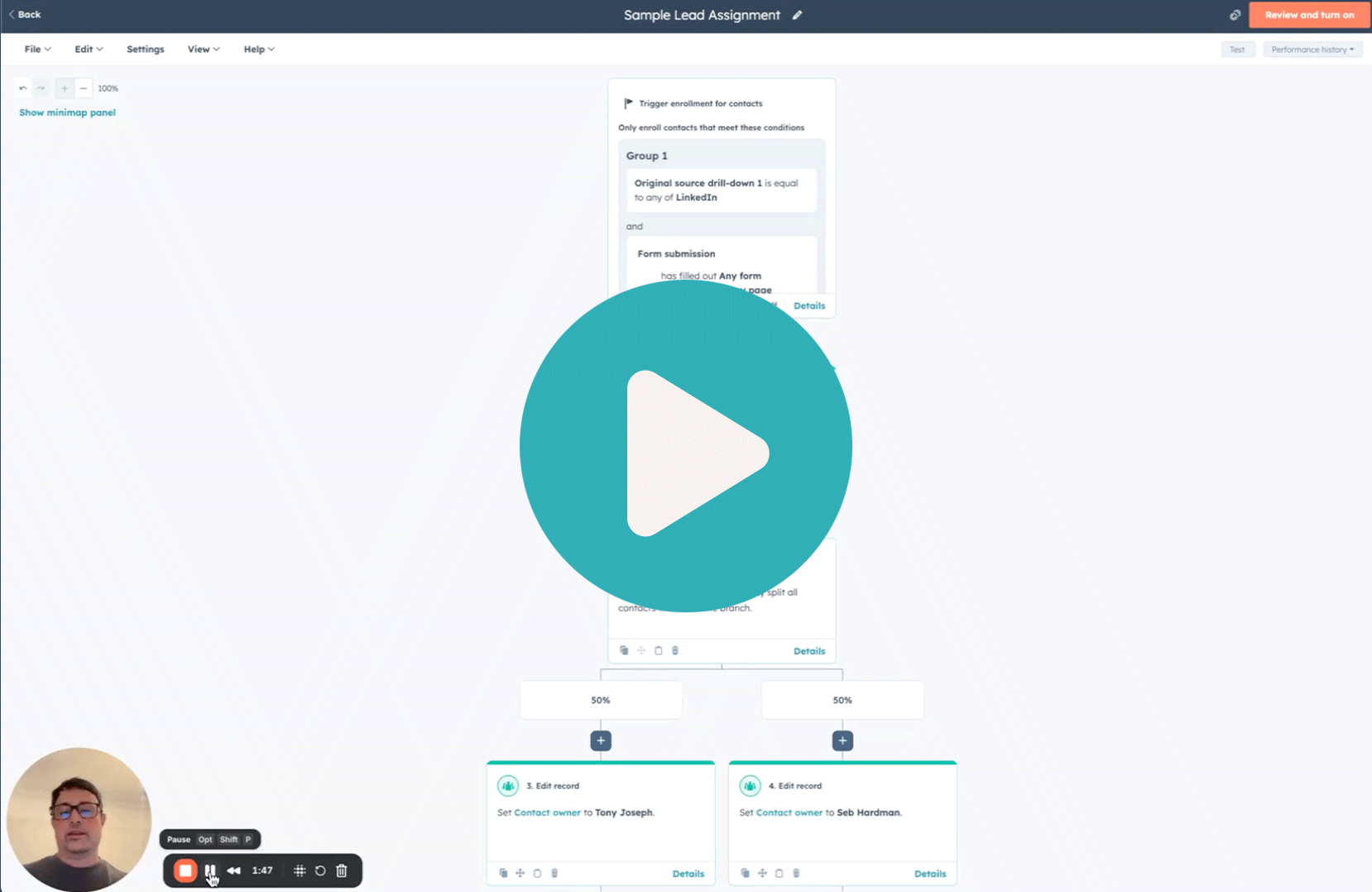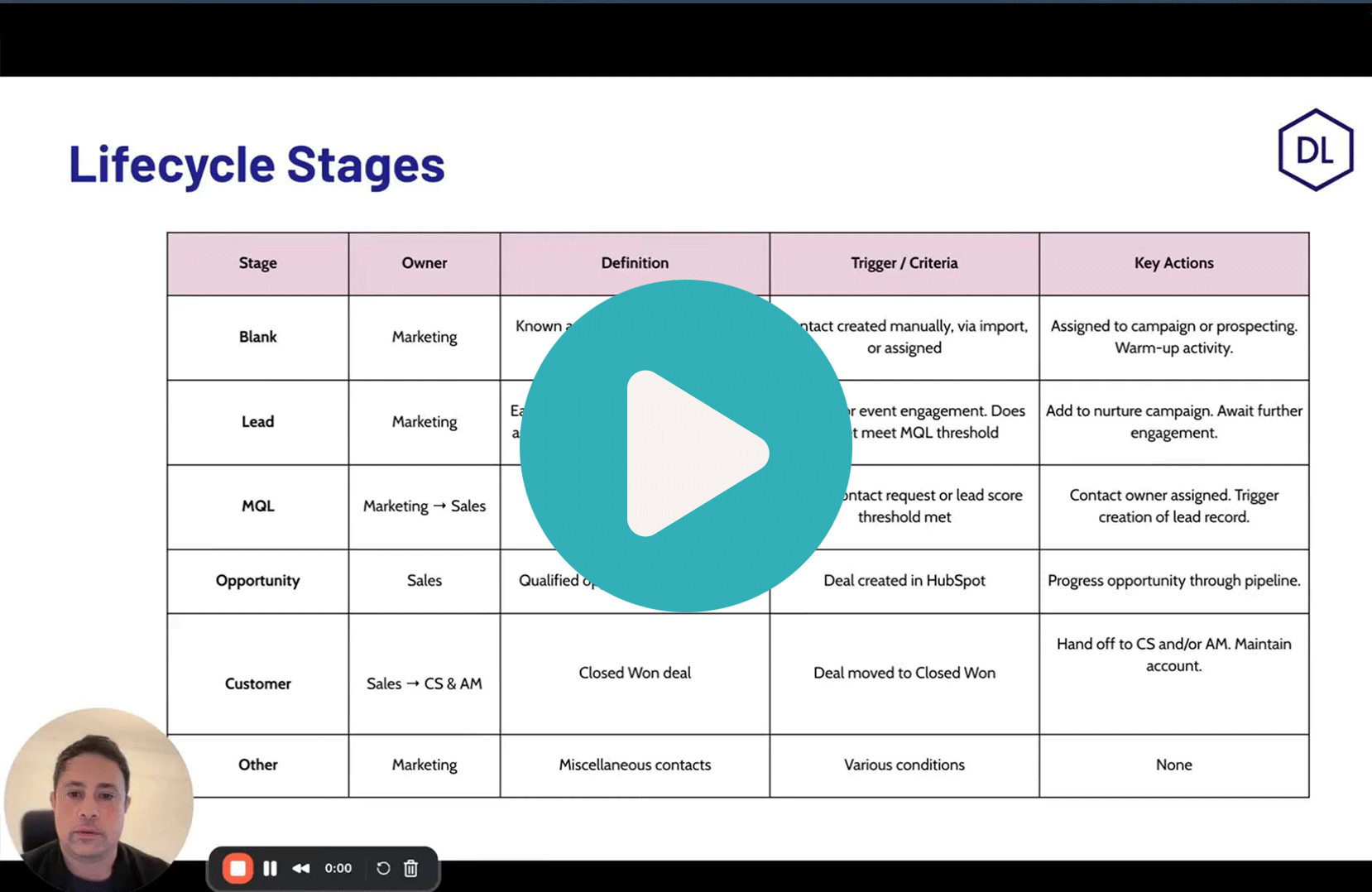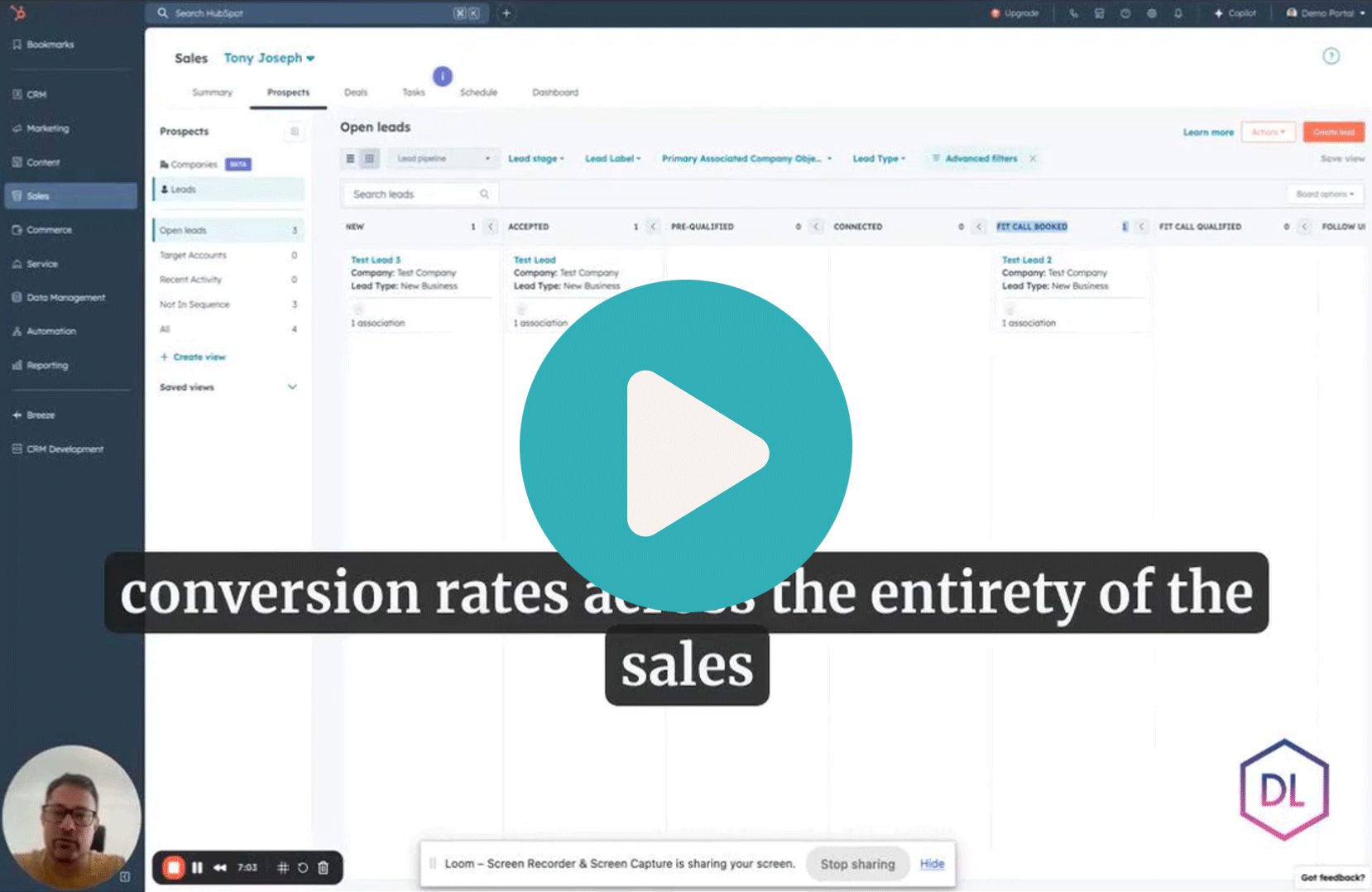The Cost of Not Having RevOps in Your Business
How misaligned operations trap 10% of your revenue, and why the first challenge is seeing where it goes

What You'll Learn
- Find out how businesses unknowingly lose 10% of annual revenue to invisible operational friction - and why the first challenge is simply seeing where it goes
- Discover why companies with RevOps functions grow faster and achieve huge ROI in their first year, whilst competitors remain trapped in manual coordination work
- Learn what sales teams actually do with their time spent working around unreliable data - and what that costs in lost pipeline opportunity
- Understand why 50% of CRM implementations fail within three years and 40% of salespeople still use spreadsheets after rollout
- See how disconnected systems and conflicting definitions create structural problems that talented people can't solve through effort alone
- Calculate the specific value trapped in your business across four areas: alignment, productivity, conversion, and decision delays
- Access the 90-day implementation roadmap showing exactly how to establish governance and capture early wins - starting with steps you can take this week
- Learn why companies that move decisively gain a 12-18 month competitive lead, and how to choose between building internally versus partnering for faster results

Businesses lose around 10% of annual revenue to operational inefficiency and misalignment (IDC). For a £50 million company, that's £5 million vanishing every year.…
Introduction
Most B2B leaders know something isn't working. Targets get missed. Forecasts get questioned. Teams seem busy, yet results don't match the effort.
Here's why. Businesses lose around 10% of annual revenue to operational inefficiency and misalignment (IDC). For a £50 million company, that's £5 million vanishing every year. Some studies suggest losses of 20-30% for companies with particularly inefficient processes.
The real problem? You can't see where it's going. Marketing, Sales, and Customer Success operate in silos with disconnected systems and conflicting definitions. When your finance director questions the pipeline forecast, you can't confidently explain the numbers. When leads leak between handoffs, nobody can pinpoint where or why.
Revenue Operations (RevOps) fixes this. It's the discipline of unifying data, process, and accountability across your entire revenue engine. Not another software platform. Not a renamed role. It's how you get Marketing, Sales, and Customer Success working from the same playbook, the same systems, towards the same goals.
This article quantifies what misalignment, poor data, failed CRM, and broken automation are costing your business. More importantly, it shows you how to capture that value, starting this week.
The Misalignment Tax
LinkedIn and Invoca research found that businesses lose £1 trillion globally to sales and marketing misalignment. When you add Customer Success (the third critical function in your revenue engine), the waste compounds further.
Let's be clear. This isn't about untalented people or toxic culture. The problem is structural.
Consider a typical scenario. A UK B2B SaaS company generates 400 leads monthly. Marketing passes them to Sales based on lead score thresholds. But Sales and Marketing never agreed on what "qualified" means. Marketing thinks qualified means two content downloads and a target account. Sales thinks qualified means budget, authority, need, and timeline.
What happens? Half the qualified leads go untouched because Sales doesn't believe they're worth pursuing. Marketing is frustrated. Sales is frustrated. Nobody owns the full customer journey, so opportunities leak at the handoff.
The leads weren't bad. The salespeople aren't lazy. The structure creates the waste.
Here's the daily reality. Your marketing operations manager spends 8 hours weekly exporting data, enriching it, importing to another system. Sales reps re-enter information Marketing already captured. Customer Success spends weeks clarifying commitments Sales made but never documented.
Aligned companies grow faster
Research from Cerius Executives found that coordination delays can cost £100,000 per campaign. Meanwhile, Aberdeen Group shows that aligned organisations achieve 31.6% annual growth versus 6.7% for misaligned companies. That's nearly five times faster growth. Not from working harder, but from eliminating structural friction.
RevOps establishes shared definitions everyone uses, connected systems that eliminate duplicate entry, and unified goals that align behaviour. When one team owns the complete customer journey, the waste disappears.
The Data Credibility Problem

Gartner research shows that 70% of B2B data becomes inaccurate each year. Job changes, promotions, company acquisitions. The business world moves faster than your database.
But data decay isn't the real problem. The deeper issue is trust.
Here's what senior leaders admitted in our research. They run quarterly forecasts in Excel because they can't trust what's in their CRM. The official system exists, but when it matters (when you need to commit to a forecast in a board meeting), you pull data into a spreadsheet because you don't believe the CRM numbers.
Why?
Nobody owns data quality. Records get created with minimal information. Updates happen inconsistently. One rep diligently logs every call. Another updates monthly. A third maintains their own system. When you query for pipeline value, you get a number, but no confidence it reflects reality.

ZoomInfo research found that sales teams lose 27% of their time working around unreliable data. That's 546 hours per rep per year spent checking, rechecking, correcting duplicates, filling incomplete fields.
Let's make this tangible. A 10-person sales team on £60,000 salaries wastes approximately £150,000 in direct salary costs managing bad data. If each rep carries a £500,000 annual quota, that lost time represents roughly £1.25 million in unrealised pipeline opportunity. Deals never pursued because reps are cleaning data instead of engaging prospects.
Leaders delay hiring because they're not confident revenue will materialise. They postpone product investments because projections might be wrong. They make reactive decisions because the data doesn't support confident planning.
RevOps builds trust
RevOps rebuilds trust through governance (clear ownership with accountability), unified reporting (one version of truth), and ongoing enrichment (continuous improvement, not periodic clean-up).
When teams believe their data, behaviour changes. Forecasts become reliable. Decisions become confident. The wasted 27% gets redirected to revenue activities.
The CRM Value Gap
Approximately 50% of CRM implementations fail within three years.
You invest £25,000 to £125,000+, migrate data, train people, disrupt operations. Yet half the time, it doesn't deliver the value you need.
The technology isn't the problem. HubSpot, Salesforce, Dynamics. These are proven platforms. The failure happens in governance and user experience.
40% of salespeople still rely on spreadsheets after CRM rollout. Why? Because the CRM became a compliance exercise rather than a valuable tool.
Here's what actually happens. A rep closes a deal. Brilliant. Now they need to update 23 fields before marking it closed. Whose budget? Contract start date? Specific products? What triggered buying? Who else evaluated?
The rep knows some of this. The rest requires digging through emails or guessing. It takes 20 minutes. Meanwhile, they have three other deals needing attention and a prospect waiting for a callback. So they update the minimum required fields, then get back to selling. The incomplete record sits in the CRM. Marketing can't analyse what's working because half the fields are blank. Sales leadership can't forecast accurately. Customer Success can't onboard properly.
The importance of RevOps ownership
Picture this. A UK tech company invests £30,000 in CRM implementation and spends four months migrating data and training teams. Fast forward eighteen months. Adoption sits at 60%. Nearly half the sales team still maintains separate tracking systems. The result? Negative ROI and a leadership team questioning whether to start over or abandon CRM entirely.
What was missing? They treated CRM as a project with start and end dates. What they needed was ongoing RevOps ownership providing governance, unified processes, continuous optimisation, and clear accountability.
Companies with strong RevOps governance report 25-35% improvements in forecast accuracy. Their CRM isn't a burden. It's the operational heartbeat.
RevOps changes the approach. Fields added only when they drive decisions. Workflows match actual selling. Automation removes burden rather than adding steps. The system provides visibility that helps reps prioritise, spot risks, close deals faster.
When reps see value, adoption follows naturally.
The Automation Trap
Businesses lose 20-30% of revenue to inefficient manual processes. For a £50 million company, that's potentially £10-15 million in operational drag.

The promise is compelling. Manual routing becomes instant. Email handoffs become automated triggers. Spreadsheet reporting becomes real-time dashboards. But here's the complication. Automation built on poor data and inconsistent processes compounds problems rather than solving them.
Here's how it typically plays out. A company decides to automate lead routing. The manual process takes 24 hours, so there's clear opportunity. They build the automation. Territory, lead score, rep capacity, all handled instantly. They flip the switch.
Within a week, chaos. Leads for the North region go to a rep who left three months ago. High-value leads go to the newest hire because rules didn't account for account status. Duplicate leads create three assignments to different reps. Edge cases break the automation entirely.
The old process was slow but worked. The automated process is fast but broken. They spend more time fixing errors than they spent on manual routing. Rubbish in, rubbish out at scale.
Get the foundation right, and results are dramatic. Companies implementing automation on solid foundations achieve 240% ROI within 6-9 months. They don't just reduce costs. They free capacity for growth initiatives.
RevOps builds that foundation systematically. Clean data through governance. Consistent processes through documentation. Clear rules through cross-functional agreement. Only when the foundation is solid does automation scale reliably.
The sequence: Fix the process, standardise it, document it, then automate it. Skip the first three and automation multiplies problems at machine speed.
The Build vs Partner Decision
Even when you're convinced RevOps is essential, implementing it poses a challenge. The constraint isn't conviction. It's capability and capacity.
RevOps requires rare skills: strategic thinking, technical capability, process design, cross-functional diplomacy, and data literacy. Finding someone with genuine depth across all five is exceptionally difficult.
The challenge compounds. RevOps needs fluency across Marketing Operations, Sales Operations, and Customer Success Operations. Most professionals specialise in one. RevOps requires all three plus the wisdom to connect them.
Operations teams acknowledged gaps candidly in our research. They lack deep RevOps expertise. Skills gaps exist in process design, data governance, HubSpot optimisation. They don't have bandwidth for transformation on top of daily operations.
The scarcity shows in salaries: Junior £35-45K, Mid £55-75K, Senior £80-120K+. For SMEs, that's significant, especially when hiring wrong sets you back 6-12 months.
Two viable paths exist:
 1. Build internally
1. Build internally
Recruit and embed your own RevOps leader. You develop internal capability and retain complete control. The trade-off is time (12-18 months to value), hiring risk, and bandwidth strain on existing teams.
 2. Partner with specialists
2. Partner with specialists
Gain immediate access to a full team with proven frameworks. Build capability through embedded collaboration whilst the partner delivers wins. Faster to value (3-6 months) and de-risked because you're not dependent on a single hire.
Neither approach is wrong. Both work when executed well. But companies often underestimate how difficult the first option is and how expensive extended deliberation becomes.
Where do you want to invest your focus? Building expertise internally or capturing market growth whilst a partner builds that expertise with you?
The RevOps Multiplier
Companies with RevOps functions achieve 36% higher revenue growth (Forrester). That's transformational.
Think about what this means. A £20 million business growing at 10% adds £2 million annually. Growing 36% faster (at 13.6%) adds £2.72 million annually. Over three years, that's over £2 million additional revenue from aligning operations.
240% ROI within first year of implementation (Symtrax). Invest £100,000, reclaim £240,000 in efficiency gains, improved conversion, recovered opportunities.
Reliable forecasting enables confident investment. Early visibility allows proactive intervention. Accurate data supports aggressive bets.

But here's what leaders actually want beyond efficiency. Predictability and confidence.
Leadership teams consistently expressed the same pain. Unpredictability. Can't forecast accurately, so can't invest confidently. No early visibility of risk, so can't intervene proactively. Question their own numbers in board meetings.
RevOps solves this. Leaders see where growth comes from and where risk emerges with clarity.
Revops delivers through aligning three pillars:
 Process
Process
One customer journey with clear ownership. Unified definitions. Documented handoffs. Feedback loops. Single owner accountable for conversion at each stage.
 Platform
Platform
 People
People
One set of goals. Shared revenue targets. Collective ownership of customer metrics. Cross-functional visibility. Aligned incentives.
Take a European B2B software company that unified its revenue operations. Within 12 months, the transformation was clear: conversion improved 22%, reporting time halved, forecast accuracy increased, and alignment scores jumped from 4 out of 10 to 8 out of 10.
The compound effect creates the multiplier. Better data enables better automation. Better automation enables stronger alignment. Stronger alignment improves data quality. Each improvement amplifies the next.
When you trust your forecast, you hire ahead of revenue. When you spot risks early, you intervene before deals slip. When you see what works, you double down with confidence.
Operational friction becomes competitive advantage through speed, accuracy, and confident decision-making.
Calculate Your Opportunity
We've created a free Google Sheet calculator showing the specific value trapped in your operations across four areas:
 Alignment Tax
Alignment Tax
Input your revenue, see the 10% loss (IDC).
For £50M = £5M annually.
Represents time reconciling data, manual coordination, lost handoffs, duplicate effort.
 Productivity Drain
Productivity Drain
Input your team size, see hours and cost wasted (ZoomInfo: 546 hours per rep).
10-person team = £180K salary costs, around £1.5M pipeline opportunity.
 Conversion Leakage
Conversion Leakage
Input your leads, current vs target conversion, deal value.
Gap between 2% and 3.5% = £3.6M annual opportunity.
 Decision Delay Cost
Decision Delay Cost
Input delayed decisions due to poor visibility.
3 per quarter at £100K = £1.2M annually.
Customise all assumptions for your reality. For a typical £50M B2B business, the calculator shows £9-10M trapped value.
What could you do with that? Fund 30-40 team members. Launch 2-3 product initiatives. Enter 3-4 new markets. Improve profitability by 20%. Accelerate growth by 36%.
If the total exceeds £250K annually, you have a clear business case.
How to Capture This Opportunity

This Week: Build Visibility
Audit 50 CRM records. If fewer than 35 are accurate (70%), you have a data problem.
Map one customer journey. More than 3 handoffs or unclear ownership = structural misalignment.
Run the calculator. Share with leadership. £250K+ opportunity = business case to act.
Ask who owns revenue operations. If the answer is "no one," that's your starting point.

The 90-Day Plan
Month 1: Audit your current state. Interview stakeholders. Identify your top 3 friction points. Most critically, establish clear ownership and accountability for revenue operations.
Month 2: Create unified definitions. Build shared dashboards. Map your ideal customer journey. Design a governance model specifying who owns what and how decisions get made.
Month 3: Deploy high-impact improvements. Automate routing based on the unified rules you established. Connect key systems. Implement enrichment. Train teams. Establish weekly check-ins.
Without clear ownership and accountability, improvements don't stick. Teams revert to workarounds. Technology investments go unused because the underlying structure wasn't fixed first.
The Choice Facing You
How much of this opportunity do you want to capture, and how quickly versus your competitors?
Every quarter, your competitors with aligned revenue operations capture additional market share. Not because their products are better or their people are more talented, but because they can see clearly, decide confidently, and execute faster.
The transformation from fragmented operations to unified RevOps shows up across seven dimensions:
 Without RevOps
Without RevOps
REVENUE: 10% trapped in friction
PRODUCTIVITY: 27% time wasted on bad data
DATA: Teams don't believe their CRM
SYSTEMS: CRM as compliance burden
GOALS: Fragmented metrics, conflicting behaviour
FORECASTING: Pipeline questioned, uncertain investment
 With RevOps
With RevOps
REVENUE: 36% faster growth
PRODUCTIVITY: Teams focused on revenue activities
DATA: Single source of truth everyone acts on
SYSTEMS: CRM as operational heartbeat
GOALS: Unified outcomes, amplified efforts
FORECASTING: Reliable visibility, confident decisions
CAPABILITY: 3-6 months with specialist partners
Implementation delivers measurable value within months. Companies that move decisively gain competitive advantage whilst others are still deliberating.
Early adopters achieve better customer experience through faster response, smoother handoffs, and consistent service. Revenue operations excellence becomes customer experience excellence, which becomes competitive differentiation.
This isn't about fixing problems. It's about capturing growth opportunity and building strategic advantage.
Some will wait. Deliberate longer. Postpone until next quarter.
Others will act. Quantify the opportunity. Establish governance. Begin capturing value.
Both can't be right. The only question is whether you'll be among the companies moving now or the ones catching up later.
FREQUENTLY ASKED QUESTIONS
What is Revenue Operations (RevOps)?
Revenue Operations (RevOps) unifies Marketing, Sales, and Customer Success under shared processes, systems, and goals. It eliminates silos by creating one customer journey, one source of truth, and one set of revenue targets across all revenue-generating functions.
What does a RevOps team actually do?
A RevOps team owns three critical areas:
Data governance: Ensures one accurate source of truth across all systems. Establishes ownership, quality standards, and enrichment processes.
Process design: Maps customer journeys, documents handoffs, creates unified definitions (like what "qualified" means), and optimises conversion at each stage.
Technology management: Integrates and maintains CRM, marketing automation, sales tools, and customer success platforms. Builds automation on solid foundations.
They work across Marketing, Sales, and Customer Success to eliminate friction, improve forecasting, and enable confident decision-making.
How much does it cost to implement RevOps?
Internal build: £50-150K+ annually for RevOps talent, plus technology costs (CRM, automation, data tools). Total first-year investment typically £100K - 200K for SMEs.
Partner with specialists: £5-15K monthly for a full RevOps programme, including team, strategy, and implementation. Typically £60-180K annually.
Payback period: Most companies achieve 240% ROI within 6-9 months (Symtrax research), meaning a £100K investment returns £240K in year one through efficiency gains and recovered opportunities.
The real question isn't cost but opportunity cost. What's it costing you to wait? Use a calculator to quantify revenue currently trapped in your operations.
Can small companies benefit from RevOps?
For companies with £1-10M revenue, focus on foundations: unified definitions, clear ownership, and connected systems. One person can own RevOps initially, supported by external expertise for specific projects.
The advantage of starting early? You build aligned operations before complexity makes it harder. It's easier to align 3 people than 30.
If your calculator shows £250K+ trapped value annually, you have a clear business case regardless of company size.
What's the difference between RevOps and Sales Operations?
- Pipeline management and forecasting
- Territory design and quota setting
- CRM for sales teams
- Sales enablement and training
Revenue Operations unifies three functions:
- Marketing + Sales + Customer Success alignment
- Complete customer journey from first touch to renewal
- Cross-functional processes and shared systems
- Single source of truth and unified goals
Sales Ops is a subset of RevOps. RevOps ensures all revenue-generating teams work from the same playbook rather than optimising one function in isolation.
Do I need RevOps if I already use HubSpot/Salesforce?
Yes. Technology is necessary but not sufficient.
The challenge isn't the platform - it's governance.
Consider:
- 50% of CRM implementations fail within 3 years
- 40% of salespeople still use spreadsheets after CRM rollout
- Platform capabilities don't matter if adoption is poor
RevOps provides what technology alone can't:
- Clear ownership of data quality
- Unified processes across functions
- Continuous optimisation and user-centric design
- Governance that drives adoption
Companies with RevOps governance report 25-35% improvements in forecast accuracy using the same CRM platforms others struggle with.
What mistakes do companies make when implementing RevOps?
Biggest mistake: Deploying technology before establishing governance.
Common failures:
- No clear ownership. RevOps responsibility scattered across teams with no one accountable. Without ownership, improvements don't stick.
- Automation before foundation. Building automation on poor data and inconsistent processes compounds problems rather than solving them. The sequence matters: fix, standardise, document, then automate.
- Treating it as a project. CRM or RevOps implementations need ongoing ownership, not start and end dates. What you need is continuous optimisation and governance.
- Designing for leadership, not users. When systems serve reporting over helping reps sell, adoption fails. 40% still use spreadsheets after CRM rollout.
- Ignoring data credibility. 70% of data becomes inaccurate annually. Without governance and ownership, teams don't trust the system and create workarounds.
Success requires governance first, technology second. Establish ownership and accountability before investing in tools or automation.





